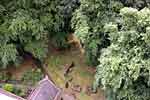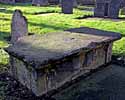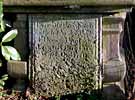For this church:    |
Basford St LeodegariusChurchyard
It extends 5,400 sq. metres or 1.3 acres, mostly to the south of the church, although formerly a little larger. Nottingham City Council paid £15 for 20 sq. yards when the River Leen was widened and Western Boulevard laid down in 1932. Recently the Council took a small part for a new footpath next to the Leen, in return laying a footpath through the churchyard, which it agreed to maintain. There are stone walls along the north boundary (Church Street) and west (an offshoot of Church Street). The back of high brick commercial premises now forms the south boundary (Western Boulevard). To the east is the River Leen. Several trees, now very tall, were planted in 1901. In his ‘Annals of Nottinghamshire’ Thomas Bailey noted a Holy Well in the churchyard in 1409. By 1837 the churchyard was ‘utterly incompetent for the growing wants of the population’ and it was resolved to find another burial ground. In 1843 the Duke of Newcastle gave 2 acres of land, known as Hill Close, on the opposite side of Church Street for a cemetery. It was closed by Order in Council on 25th October 1881. Its successor, Basford Cemetery on Nottingham Road, had opened in 1874.
The oldest monument may be a large table tomb near the south porch which bears crossed spears and a skull but no trace of an inscription. Leaning against the south wall of the nave outside is a large stone which once lay in the church. It was said to be the mensa of a pre-Reformation altar but does not bear identifying marks. The inscription is to the Rev John Clark, former rector of Cotgrave, who was ejected in 1662 for refusing to conform to the Established Church. He settled in Basford and held services in his house until he died in 1669. Just to the west of the south porch is a table tomb to Henry Ward who died in 1736, aged 108. He became a burgess of Nottingham when he was 106 - his vote was needed - although he had been entitled to the privilege since he was 21. Near the main gate is said to be the grave for James Towle who was hanged for his part in Luddite riots in 1816. There are several attractive Swithland slate headstones, made by Sparrow of Radcliffe-on-Trent and Walker and Radcliffe of Nottingham. Perhaps the best is that now fixed to the outside of the south porch, by Radcliffe for William Adkinson, Parish Clerk, who died in 1777. Most graves are to the south of the church but a dozen are found at the north west corner and one to the north east. |










